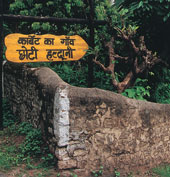 |
 |
You sense the leopard stalking you as you walk down the narrow jungle trail with Mohan Pande. Wily and old, the man-eater silently follows you as you make your way through the lantana bushes towards the dry river bed. A barking deer calls out from the opposite bank; the sun is obscured by monsoon clouds above. A bunch of monkeys panic and raise hell on the tree tops.
Fifty metres short of where the kill was reported two days ago, Pande messes it all up. “Delhi must be hotter than it is here, no?” he asks out of misplaced courtesy. Fantasy goes crashing out of the window; the .275 Rigby, whose safety catch you were almost about to release, reverts instantly to its less-fancied form of a water bottle. You take a swig and move on. Playing Jim Corbett in modern-day wilderness comes with its own set of circumstantial hazards, even if you try it in his own backyard.
Pande tells you more about Chhoti Haldwani ? the village that Corbett built ? as he takes you down the trail. The legendary hunter set up the Uttaranchal hamlet in 1915 after he bought 221 acres of land some 30 km southeast of what is now the Corbett National Park, and invited 40 families to take up lodging there. “His 130th birthday falls on Monday, do you know?” the guide adds as an afterthought.
A five-day festival is being planned in the village to mark the occasion. But apart from the token event, a bigger development has kept the villagers on their toes of late. Propelled by some out-of-the-box thinking by local wildlife officials, Chhoti Haldwani is set to open its doors to all those people who preferred The Man-Eaters of Kumaon to Algebra Made Easy during their school days. Heritage tourism is on the cards for the village’s 200-odd residents, and few are willing to give the new revenue-generating exercise a miss.
“It began primarily as a project that would give the villagers an additional means of income,” says Rajiv Bhartari, director, Corbett Tiger Reserve, of the scheme. A plan was drawn up late last year to devise a mode of alternative tourism based on the heritage value of the village. “The idea was to ensure that every villager got a share of the tourism pie,” he says.
The jungle trail was thus marked out for nature lovers, and guides for the trek were trained at the ecotourism centre in Chuna Khan, 10 km away. Communication and courtesy were stressed and basic knowledge of botany and zoology was imparted. “Language still remains a problem,” says Bhartari, possibly keeping in mind the foreign tourists who could soon come calling.
Within the village, the chaupal, a two-storey construction, which Corbett built to facilitate village conferences, was given a fresh coat of paint. Trilok Singh, now in his late 60s, mans the chaupal, and for added effect, poses for photographs with the single-barrel muzzle-loader that Corbett had gifted his aide and Trilok’s father Sher Singh, “It still works,” he says with a smile.
Then, there’s the storytelling session with Devvan Goswami, one of the few people in the vicinity to have known Corbett personally before the hunter-writer left India for Africa in 1947. “I was about 10 years old then, and used to carry milk and honey to sahib’s house every day,” says the 70-year-old with a glint in his eye. “And he taught me A-B-C-D in return. He also took me to the forests and taught me many things about the jungle,” he says.
A part of the Rs 200 that a guide charges for showing tourists around the village goes to Goswami and Singh for their efforts. For the veterans, it’s good money, considering they already have their own means of sustenance ? a tea stall and livestock, respectively ? to fall back upon.
The shelves at the souvenir shop of the nearby Jim Corbett Museum, on the road that connects Kaladhungi to Ramnagar, has been made accessible to the villagers, says R.C. Kandpal, forest ranger of the Bijrani range. Mangoes from the grove of the museum ? once Corbett’s winter house ? are pickled and sold at the shop by the women of the village. “Imagine how it might feel for tourists to carry home pickle made of mangoes from Corbett sahibs’s garden,” Kandpal exclaims.
At the house of Mothi Singh, one of Corbett’s most trusted hunting companions, visitors are welcomed with a cup of tea. “You must have read about my grandfather in My India,” says Singh’s grandson Madan. “Corbett sahib built this house with his own money for him,” he says. “He gave it to my grandfather for free, just like he gave away the whole village to its villagers before leaving for Africa.”
Whether Madan should charge visitors for the tea or not is an issue currently being deliberated upon ? like many other issues that are still being thrashed out before Chhoti Haldwani finally takes the plunge into the tourism industry. “The scene should be set before the Corbett reserve reopens in November,” says Bhartari. “We also have plans to conduct one-day excursions to Chhoti Haldwani from the Corbett park to promote tourism in the village,” he says.
That should be a cakewalk, for the Corbett magic clearly still endures. Oxford University Press, Corbett’s first publishers, say the cumulative sales of his works have crossed the one-million mark. “His books have never gone out of print,” says an official at the publishing house. If Corpus Corbetti still reigns as an evergreen favourite, there’s no saying how many of his fans out there would take the heritage bait hook, line and sinker. For Chhoti Haldwani, it would mean registering catches way bigger than the giant mahasheers Corbett often hooked on his fishing trips.
Sure, Goswami may soon tire of having to reiterate the same story over and over again in a single day. And the chances of a leopard prowling on the jungle trail would be reduced to a virtual nought. But then, tourism is always about making compromises, isn’t it?











